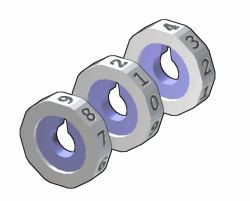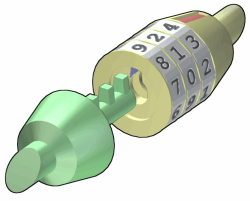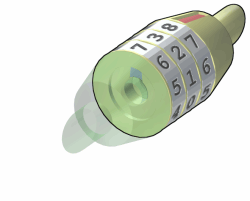A combination lock is a type of padlock in which a sequence of numbers is used to open and close the lock. The sequence may be entered using a set of independently rotating discs with inscribed numerals. The discs directly interact with the locking mechanism, following the principle outlined using the following illustrations.



Assignment
Write a class CombinationLock which can be used to initiate objects that represent a combination lock having $$d \in \mathbb{N}_0$$ rotating discs. Each disc is inscribed with the integer series 0, 1, …, $$m$$. There is a single correct combination to which the discs must be set in order to open the lock. The objects of the class CombinationLock must at least support the following methods:
An initialization method that takes a sequence (a list or a tuple) of integers as its argument. These integers indicate the correct combination to open the lock. The number of integers $$d \in \mathbb{N}_0$$ corresponds to the number of discs of the lock. Initially each lock is set to the value zero. In addition, the initialization method has a second optional parameter maxvalue that takes the maximal value $$m \in \mathbb{N}_0$$ with which the discs are inscribed (default value: 9). The lock needs to have at least a single disc, and each integer in the correct combination must be in the interval [0, $$m$$]. If this is not the case, the initialization method must raise an AssertionError with the message invalid combination.
A method __repr__ that must return a string representation of the object in the format CombinationLock(t, maxvalue=m), where t is a tuple that contains the integer sequence that forms the correct combination to open the lock, and m represents the maximal value with which the discs are inscribed.
A method __str__ that must return a string representation of the object. This string representation must contain the integer sequence to which the discs are currently set, separated from each other using dashes.
A method rotate that can be used to rotate one or more discs over a given number of positions. This method takes two arguments: i) the discs that need to rotated, and ii) the number of positions the discs need to be rotated. Disc are always rotated to a larger value, where after the integer $$m$$ the disc is rotated to zero. To indicate which discs need to be rotated, the discs are increasingly indexed from left to right, starting at zero. In case a single disc needs to be rotated, the index of the disc (integer) is passed as the first argument. In case multiple discs need to be rotated, a collection (a list, tuple or set) of disc indices (integers) is passed as the first argument. If the index of a non-existing disc is passed to the method rotate, an AssertionError must be raised with the message invalid disc. In that case, non of the given discs must be rotated.
A method open that returns a Boolean value indicating whether or not the discs are set to the correct combination that opens the lock.
Example
>>> lock = CombinationLock((9, 2, 4))
>>> lock
CombinationLock((9, 2, 4), maxvalue=9)
>>> print(lock)
0-0-0
>>> lock.open()
False
>>> lock.rotate(1, 2)
>>> print(lock)
0-2-0
>>> lock.rotate(2, 5)
>>> print(lock)
0-2-5
>>> lock.open()
False
>>> lock.rotate([2, 0], 9)
>>> print(lock)
9-2-4
>>> lock.open()
True
>>> lock = CombinationLock([14, 13, 2, 7, 6], maxvalue=16)
>>> lock
CombinationLock((14, 13, 2, 7, 6), maxvalue=16)
>>> print(lock)
0-0-0-0-0
>>> lock.rotate([0, 2, 4], 6)
>>> print(lock)
6-0-6-0-6
>>> lock.rotate([1, 3, 5], 13)
Traceback (most recent call last):
AssertionError: invalid disc
>>> print(lock)
6-0-6-0-6
>>> lock.rotate([1, 3, 2], 13)
>>> print(lock)
6-13-2-13-6
>>> lock.rotate([0, 3], 8)
>>> print(lock)
14-13-2-4-6
>>> lock.open()
False
>>> lock.rotate(3, 3)
>>> print(lock)
14-13-2-7-6
>>> lock.open()
True
>>> lock = CombinationLock([1, 2, 3, 4, 5], maxvalue=4)
Traceback (most recent call last):
AssertionError: invalid combination
>>> lock = CombinationLock([])
Traceback (most recent call last):
AssertionError: invalid combination